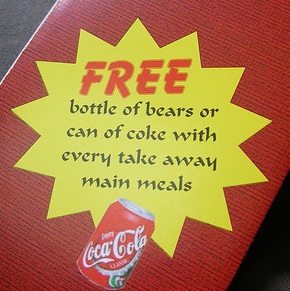Powerful Pricing Strategies
Despite being one of the cornerstones of any successful marketing strategy, pricing often gets overlooked when small businesses are getting set up. Even when thought and research are put into pricing strategies, many businesses keep their prices static, despite the fact that small changes to your pricing strategy can have a dramatic effect on conversion rates and bottom lines.
Like every aspect of marketing, successful pricing is only achieved through trial and error, and constant tweaks and changes, so give these pricing strategies a try in your own business and see how you can increase your business’s profits for yourself!

1. Know Your Customers
In our monthly Digital Marketing Courses at the British Library, we often talk about the importance of identifying and visualising your customer personas. Creating a detailed customer persona makes it easier to gauge how much your customers are willing to pay.
This is a crucial part of your pricing strategy, as if you fail to profile your ideal customer, and thereby miscalculate what your customers feel your product is worth, you risk alienating your core audience through badly-thought out pricing strategies.
Ask yourself what your customers value.
Are they bargain hunters out for a great price, or do they value high quality and a premium product or service?
It all comes down to who you should be selling to and the positioning of your product.
Much of how your customers perceive your brand and what you offer is down to how much you charge.
For example, in Northern America, Pabst Blue Ribbon (PBR) is seen as a budget beer, associated with arty urban types and poor people. However, in China, PBR is marketed as a super exclusive Champagne alternative which will set you back $44 a bottle!
To be clear, the product is exactly the same, and exporting costs are negligible in comparison to the mark-up. The only reason PBR has been marked up by such a huge margin is because of savvy marketing and product positioning.
If PBR had been marketed as a low-cost beer of the people, it would have had little traction in a Chinese market which already has a range of budget beers.
However, by taking a radical approach with their pricing strategy, they positioned themselves as an exclusive brand for the wealthy and carved out an insanely profitable niche for themselves.
Let’s just hope, for PBR’s sake, that no Chinese millionaires ever find themselves in the budget beers section of a down-market liquor store in Texas.
Incidentally, PBR’s Chinese pricing brings us onto our second point:
2. A Lower Price Is Not Necessarily a Better Price

When you are first starting out, it can be tempting to try and price yourself lower than your competitors to try and tempt customers away from them. It seems like a flawless strategy, right? After all, you’re offering just as good a product, but at a reduced rate – what’s not to like?
Well in actuality, pricing yourself lower might be hurting more than just your profit margins.
First and foremost, as we have already discussed, pricing is a huge indicator of quality to customers.
Although you may think that you will tempt customers with an irresistible offer that’s based on price, your comparatively low prices will make them think “what’s wrong with this product? Why do they need to price themselves much lower than everyone else?”
It’s worth remembering that even bargain hunters are looking for great value, as opposed to just a low price. When you price yourself so low, you will be attracting customers who either:
- Hate spending money, and are unconcerned with quality
- Have no money to spend and therefore have no choice over quality
- Are not long-term quality customers who’ll spend a lot of money with you
We’ve had an example of this, when our client did a Groupon deal and got 1,000 customers.
We had to work with him really hard, and it took a while, but eventually he managed to work out a specific price point upsell with benefits that worked.
However, we’ve heard that with Groupon, there has been people who have had a sauna or a massage at a clinic, and have stolen goods they didn’t pay for. So just be careful with the type of customers that you bring in.
These types of customer can spell disaster for any SME.
Developing a relationship with customers and converting them into repeat buyers and advocates for your brand is any small business’s dream scenario. How can you expect this to happen when your customers don’t care about quality or don’t have the money to buy more stuff from you!
Therefore, if you can and do price yourself lower than the competition, your marketing can’t just focus on the fact that you are cheaper – it has to focus on why you are cheaper. Let’s use online fitness supplement retailer Myprotein as an example.
MyProtein
Over the last decade or so, fitness has become a massive industry, which is worth billions in the UK alone.
The fitness industry is worth so much not only because of its popularity, but because fitness enthusiasts are willing to pay over the odds for quality in pursuit of their ideal bodies!
Protein powders are a prime example of this, as not only is the price hugely marked up, but fitness buffs tend to prefer premium priced products over cheaper alternatives, due to the perceived quality.
Therefore, budget protein seemed like a doomed proposition, as the perception of lower quality would alienate the hardcore customer base.
However, what Myprotein did was focus their marketing on why their product was so much cheaper and how this enabled them to sell quality supplements at a reduced rate. By allowing customers to understand why their product was priced how it was, Myprotein was able to rapidly expand and is now arguably the most dominant sports supplement company in the UK.
3. Keep an Eye On What Your Competitors Offer
I know we’re always badgering on about competitor analysis, but we only do so because it is one of the quickest and easiest ways to nail your marketing and really capitalise upon your competitor’s successes.
However, when it comes to competitors and their pricing strategies, far too many business owners just look at what their competitors are charging, instead of what their competitors are offering.
What your competitors are charging is not as relevant as you might think it is; after all it’s all about judging the value of what you offer, compared to your competitors.
For example, does your product come with an extended warranty or guarantee, which no other competitors offer? Then you need to ask yourself what that peace of mind is worth to your customers and how that changes how much you charge for your product.
Conversely, perhaps you are not yet in a position to offer the same sort of quality or wealth of services as your competitors, in which case it might be appropriate to price yourself lower than them.
However you fare against your competitors, remember to always compare your services and value, not just the price.
4. Safeguard Yourself against a Price War
Because small businesses rely on higher profit margins to survive, it means that they can be easily priced out by corporations and bigger companies.
For example, an independent jam maker is never going to be able to undercut Tesco, and still make a profit. They simply can’t rival the volume big retailers deal with. When small businesses try to undercut bigger stores, it can spark a price war, which is almost always disastrous for the smaller company.
So, if small businesses are unable to price themselves competitively, how can they protect themselves from being radically undercut by bigger companies?
1. Turn Your Small Volume into an Advantage
Whilst your small production volume might prevent you from pricing aggressively, it can also work in your favour, as it enhances exclusivity, which in turn means that you can justify charging more.
2. Identify What Value You Can Add Which Bigger Competitors Can’t
As a small business, you are always going to be more agile and flexible than bigger competitors, which means that you can offer benefits and perks which they cannot. Because you sell so much less, you can concentrate on making every customer feel valued and provide an excellent experience.
Before you know it, you’ll be attracting customers who are willing to pay more for outstanding customer service and that will be one of your USPs.
Build Your Brand
If your customers come to know and trust your brand, you will be able to weather any price war because your customers specifically want to buy from you, and are willing to pay more for that privilege. This all comes down to the strength of your brand and your relationship with your customers.
As long as you offer something which bigger competitors cannot, and make sure that your brand has a reputation for that service, you’ll always retain your core customers, no matter what price fluctuations happen in your industry.
5. Understand How Action Paralysis Can Affect Your Conversions
Action Paralysis is the phenomenon of customers being overwhelmed by too many choices and therefore feeling unable to actually make a choice.
This same phenomenon can affect your pricing strategy too, as if similar products are priced identically, consumers can find it difficult to make a choice, and end up buying nothing.
In a study conducted by Yale university, users were presented with 2 packs of chewing gum, both priced at 63 cents. They were given the option to buy one pack or pass and keep the money.
Only 46% made a purchase.
However, when the packs were priced slightly differently, at 62 cents and 64 cents apiece, 77% of users chose to buy a pack. Such a nominal price change caused a huge jump in conversions.
The reason this tactic eliminates any action paralysis is because it simultaneously appeals to two distinct sets of buyers:
- the bargain hunters who prefer lower prices
- the “big spenders” who associate price with quality
The goal here isn’t to try and rip off any big spenders by radically up-marking certain products, but to provide a small price difference which will eliminate any action paralysis your visitors might experience and compel them to buy from you.
We’ve also had personal experience with Amazon.
Some people who are selling products on Amazon have actually put their prices up and sold more!
Sometimes this was done because people were running low on stock, however the fact that they sold more, shows just how changes to pricing can have a positive impact on the perceived value of your products.
6. The Power of Price Anchoring
Have you ever been to a fancy restaurant, seen that the Sea Bass costs about the annual GDP of a small nation, and been fooled into thinking you’re getting the deal of the century by buying a cheese sandwich for £10?
This temporary lapse in financial sanity is down to a natural cognitive bias called “anchoring”.
As humans, we place a lot of significance on the first piece of information we see and allow that to become a reference point, or benchmark, which influences our decisions.
This is why the £10 cheese sandwich seems like such a bargain compared to the extortionate Sea Bass. However, if that same £10 cheese sandwich was included in a Wetherspoon’s menu, it would seem like a cruel joke.
You can use this lapse in mankind’s mental reckoning to increase your own sales, by placing relatively expensive products next to super premium products.
Having worked with 100s of businesses, we’ve seen for ourselves how these pricing strategies can increase sales and boost profits, but we’d love to hear any novel pricing strategies which were particularly successful for your business in our comments section below.
Discover
The 12 Marketing Secrets of Fast-Growth Companies
Find out what they do to achieve outrageous business success

Get your free copy

 By
By 


Great tips Alasdair, many thanks for the generosity of sharing.